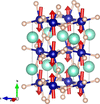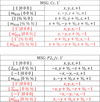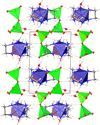issue contents
October 2024 issue

Cover illustration: Topologically distinct polyhedral micro-ensembles (PMEs) in the crystal structure of a potassium calcium silicate representing the first known compound containing [Si6O19]-oligomers. The crystal structure can also be described as a mixed tetrahedral-octahedral framework, based on corner-sharing [SiO4]- and [CaO6]-units. On the lowest sublevel, the PMEs are formed for each octahedron and tetrahedron in the asymmetric unit by considering all directly bonded [CaO6]- and [SiO4]-groups. They represent a geometrical interpretation of the coordination sequences up to the index k = 3. See Kahlenberg et al. [Acta Cryst. (2024), B80, 474–487].
editorial

scientific comment
 access
accesstopical reviews
 access
accessmagnetic structures
 access
access access
access access
access access
access access
accessshort communications
 access
accessresearch papers




 access
access

 access
access

 access
access

 access
access


 journal menu
journal menu












































